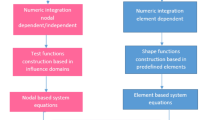Abstract
This paper presents a review of research work in recent years on the method of weighted residuals (MWR) on solid mechanics in the People's Republic of China. MWR, as a kind of mathematical method by which approximate solutions of differential equations may be obtained, is being extensively used in the fields of fluid mechanics, heat transfer, etc. In China, prompted by needs, this method has been developed to be used on solid mechanics in recent years and has also been recognized as having merits over other methods.
In this paper, after a brief description of MWR, a review of this method as applied in members, plates, shells, latticed shells, elasticity problems of two dimensions and three dimensions, research on its functional theory and theory of convergency, on positions of collocation points, selection of trial functions, the use of the spline function and beam functions, nonlinear problems and its application in time domains are given.
Finally, the author, summarizing investigations in the past, suggests several future research directions for MWR which may be advantageous to the industrialization of China.
Similar content being viewed by others
References
Finlayson, B. A.,The Methods of Weighted Residuals and Variational Principles with Application in Fluid Mechanics, Head and Mass Transfer, Academic Press, (1972).
Finlayson, B. A. and L. E. Serven,The method of weighted residuals—a review, Applied Mechanics Review, Vol. 19, No.9, (1966).
Eason, E. D.,A review of least-squares methods for solving partial differential equations, Inter. Journal of Numerical Methods in Engg. Vol. 10 (1976), 1021–1046.
Xu Ci-da,The method of weighted residuals on solid mechanics, Mechanics and Practice, No. 4, (1980). (in Chinese).
Xu Ci-da and Shi De-feng,Discrete method of least squares in analysis of plate-bending problem, Acta Mechanica Sinica, No. 4, (1981). (in Chinese).
Xu Ci-da, Zheng Rui-fen and Shi De-feng,The least-square collocation method used in plate-bending problem, Shanghai Mechanics, Vol. 1. No. 2, (1980), 17–33. (in Chinese)
He Guang-qian and Zhang Wei-yue,Moment theory analysis of hyperbolic paraboloid shells by the boundary collocation method in the sense of least squares, Jour. of China Civil Engg. No. 1, (1980) 11–22. (in Chinese)
Qiu Ji-bao,Variation of mean-square functional and method of discrete least-squares with gauss collocation points, Proc of the National Congress of Computational Mechanics, Hangzhou, China, (1980). (in Chinese)
Qin Rong,Methods of spline MWR, Proceedings of Guangxi Society of Mechanics, March, (1980). (in Chinese)
Qin Rong,Collocation methods with splines and energy principles, Guangxi Society of Mechanics, March, (1980). (in Chinese)
Chen Zi-qi,Use of beam function in MWR to solve plate-bending problems of small deflection and large deflection, Master Degree Thesis, Tongji University, Oct. (1980). (in Chinese)
Jin Rui-chun and Xu Zhi-xin,The weighted residual method and the high precision integration scheme, Jour. of Tongji University (1980). (in Chinese)
Author information
Authors and Affiliations
Rights and permissions
About this article
Cite this article
Ci-da, X. Recent advances in the method of weighted residuals on solid mechanics in China. Appl Math Mech 3, 793–800 (1982). https://doi.org/10.1007/BF01895334
Received:
Issue Date:
DOI: https://doi.org/10.1007/BF01895334




